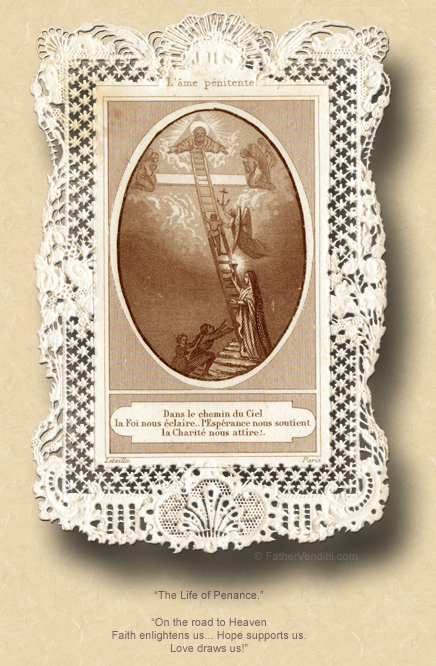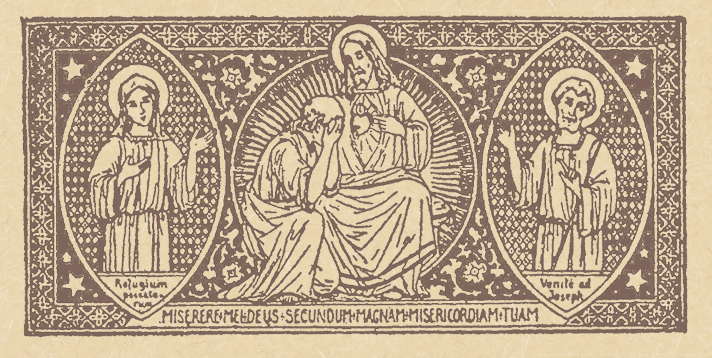"I Can Only Take the Clergy in Small Doses."
The Memorial of Saint Vincent de Paul, Priest.
Lessons from the primary feria, according to the ordinary form of the Roman Rite:
• Ezra 9: 5-9.
• [Responsorial] Tobit 13: 2-4, 7-8.
• Luke 9: 1-6.
|
…or, from the proper:
• I Corinthians 1: 26-31.
• Psalm 112: 1-9.
• Matthew 9: 35-38.
…or, any lessons from the common of Pastors for Missionaries, or the Common of Holy Men and Women for Those Who Practiced Works of Mercy.
|
The Third Class Feast of Saints Cosmas & Damian, Martyrs.*
First & third lessons from the common "Sapiéntiam…" of Many Martyrs, Gradual from the proper, according to the extraordinary form of the Roman Rite:
• Wisdom 5: 16-20.
• Psalm 5: 12-13.
• Luke 6: 17-23.
The Sixteenth Wednesday after Pentecost; the Feast of the Holy Martyr Callistratus & His Companions; the Feast of Our Venerable Father Nilus; and, the Feast of Our Holy Father Vincent de Paul.**
Lessons from the pentecostarion, according to the Ruthenian recension of the Byzantine Rite:
• Ephesians 3: 8-21.
• Luke 5: 33-39.
FatherVenditti.com
|
 7:57 AM 9/27/2017 — Vincent de Paul’s name is familiar to us probably because of the Saint Vincent de Paul Society, a charitable organization for men which remains active in the Church in many parishes. He wasn’t the founder of it, it’s just named after him. 7:57 AM 9/27/2017 — Vincent de Paul’s name is familiar to us probably because of the Saint Vincent de Paul Society, a charitable organization for men which remains active in the Church in many parishes. He wasn’t the founder of it, it’s just named after him.
Born 1660, he started out as a secular priest, like myself, having been ordained for the local diocese which, in his case, was the Archdiocese of Paris; but, he soon found himself scandalized by the worldly ways and lax attitudes of many of his brother priests. Understand that, while the Council of Trent was well over by this time, it took many decades for the reforms that Council had mandated to be applied throughout the Church, particularly those regarding the life and discipline of the clergy. In one passage of his writings as a young priest, he described what it was like walking into Notre Dame Cathedral and viewing the priests of the Cathedral Chapter offering Masses at the various side altars, and how each one was doing it differently. One priest, he said, would begin Mass with the Our Father; another was fond of skipping the Epistle; he even saw one priest who was in such a hurry that he would throw his chasuble on over his hunting clothes. When he was asked by his dean why he never attended the meetings of the clergy, he replied, “I can only take the clergy in small doses,” and later is reported to have said, “There is no greater cross for me in his life than attendance at an ecclesiastical gathering.”
Of course, he didn’t simply observe and complain about these things, but worked tirelessly among his brother priests to encourage greater holiness of life, as well as encourage them to show more concern for the poor in their parishes, in spite of the fact that he, himself, never served as pastor of a parish. These efforts ultimately led to the creation of a new religious community, the Congregation of the Missions, which is today known simply as the Vincentians, dedicated not only to the education and reform of the clergy, but also to providing missionary priests to France’s colonies around the world. Together with the future Saint Louise de Marillac, he founded the Daughters of Charity as a semi-contemplative community of women dedicated to hospital work.  He preached vigorously against the heresy of Jansenism, encouraging the frequent reception of Holy Communion long before Pius X came along, and is today regarded as the patron saint of charities, hospitals, prisons, as well as being the patron saint of the Republic of Madagascar—don’t ask me why. His mortal remains are enshrined for public view under an alter at the Vincentian’s mother house in Paris, and are incorrupt. He preached vigorously against the heresy of Jansenism, encouraging the frequent reception of Holy Communion long before Pius X came along, and is today regarded as the patron saint of charities, hospitals, prisons, as well as being the patron saint of the Republic of Madagascar—don’t ask me why. His mortal remains are enshrined for public view under an alter at the Vincentian’s mother house in Paris, and are incorrupt.
As we turn now to today’s Scripture lessons, we focus today briefly on our first lesson from the Book of Ezra, one of two historical works—the other being Nehemiah—that cover a one hundred year period following the Edict of Cyrus in 538 BC, which allowed the Jewish people to leave captivity in Babylon and return to Jerusalem. Cyrus the Great, the Emperor of Persia in modern day Iran, had conquered the kingdom of Babylon, and one of his first acts was to release the Jews from bondage and send them home. The problem was that the Jews, during their long years of captivity, had become corrupted, intermarrying with pagans, forgetting and abandoning their faith, falling into sinful ways. Ezra became their self-appointed leader, and soon realized that the Jews couldn’t very well return to Jerusalem, now in ruins, and restore their once-great kingdom without the help of God, which meant that they needed to rediscover their faith.
Our first lesson is taken from the middle section of the book in which Ezra begins the task of rebuilding the Temple in Jerusalem, and it consists of Ezra’s prayer to God to have mercy on His people and forgive them of their sins:
O my God, I am all confusion, I am ashamed to lift my eyes towards thee; so deep, head-deep, are we sunk in the flood of our wrong-doing, so high, heaven-high, mounts the tale of our transgressions (9: 6 Knox).
Ezra, alone, knows the gravity of the sins of his people. Like a true leader should, he anticipates the Passion of our Lord in allowing all his people’s sins to be projected onto himself, and begs the Lord’s mercy. His prayer could be used by us as a preparation for making a confession with true contrition.
The take-away for us is how the forgiveness of our sins is offered to us only as a result of genuine sorrow. Ezra felt that sorrow deep within him, and knew that there would be no point in rebuilding the temple until his people had become, once again, worthy to enter it, just as we must beg mercy from our Blessed Lord with a real and true contrition if we are to approach our Lord in the Blessed Eucharist worthily. Let us beg our Blessed Lord to give us that true contrition so that we can confess our sins sorrowfully and receive Him worthily.

* Cosmas and Damien were brothers and physicians born in Syria, known in the Eastern Churches as the "unmercenaries" because of their devotion and care for the sick poor. They were tortured and beheaded in Cilicia under Diocletian by order of the prefect Lysias in the year 283. The are specifically mentioned both in the Roman Canon and in the “proscomedia” (preparation rites) of the Liturgy of John Chrysostom.
** Callistratus and his companions were martyred in the city of Byzantium under Diocletian toward the beginning of the fourth century.
Born in the year 910, Saint Nilus the Younger (in Italian: San Nilo di Rossano), was a monk, abbot, and founder of Italo-Greek monasticism in southern Italy. He is remembered principally as the founder of the monastery of Grottaferrata near Frascati, and is counted the first abbot. The abbey continues to this day. He spent the end of his life partly in the Sant'Agata monastery in Tusculum and partly in a hermitage at Valleluce near Gaeta. He died in the Sant'Agata monastery in 1005. Born in Calabria in that portion of the region which belongs to the Italo-Byzantine Catholic Church, he is regarded as one of that Church's most important saints. Cf. the footnote attached to the post here for more information about this Eastern Catholic Church.
|

